Revolutionizing Software Testing: Unveiling the Future of Quality Assurance
In the ever-evolving world of software development, the need for robust and efficient software testing processes has never been more critical. The rapid pace at which applications are developed and deployed demands that quality assurance keeps up, ensuring the delivery of flawless products. However, traditional testing methods often fall short in meeting these demanding timelines and complexities. So, how do we bridge the gap between speed and quality in today’s digital landscape?
The answer lies in embracing innovative solutions that leverage cutting-edge technology to revolutionize software testing. One such approach is the integration of AI-powered tools like GenQE, which promise to transform the way we think about and execute software testing. But what exactly makes these modern solutions stand out from conventional practices? And how can they be seamlessly integrated into existing workflows to maximize efficiency and accuracy?
In this comprehensive exploration of software testing, we will delve into the challenges faced by developers and testers alike, uncover the latest advancements in testing methodologies, and highlight the transformative potential of AI-driven tools. By the end of this article, you’ll gain valuable insights into the future of software testing and discover practical strategies to enhance your testing processes.
The Evolution of Software Testing

The journey of software testing has been one of continuous evolution. From the early days of manual testing to the current era of automated and AI-driven approaches, the field has seen significant advancements. But what has driven this evolution, and why is it necessary?
From Manual to Automated Testing
In the early stages of software development, testing was predominantly a manual process. Testers would manually execute test cases, record results, and identify defects. While this approach was effective for smaller applications, it became increasingly time-consuming and error-prone as software grew in complexity. The advent of automated testing tools marked a significant turning point, allowing teams to automate repetitive tasks, improve accuracy, and accelerate testing cycles.
Automation tools such as Selenium and Appium enabled large-scale testing efficiency by simulating user interactions and executing pre-defined scripts across various browsers and devices. This shift not only reduced human error but also allowed for more frequent testing, aligning with agile development methodologies. Moreover, automation facilitated regression testing a crucial aspect of maintaining software integrity with each new release.
“Automation has become a cornerstone of modern software testing, enabling teams to achieve higher levels of efficiency and precision.”
The Rise of AI-Driven Testing
As technology continued to advance, the introduction of artificial intelligence (AI) and machine learning (ML) into software testing brought about a new era of possibilities. AI-driven testing tools, such as GenQE, have the capability to analyze vast amounts of data, generate intelligent test cases, and even predict potential defects. This shift towards AI-powered testing is not just about automation; it’s about augmenting human capabilities to achieve unprecedented levels of quality and speed.
AI tools analyze patterns from previous test runs, user feedback, and application logs to predict where defects are most likely to occur. This predictive capability allows teams to focus their efforts on high-risk areas, increasing the likelihood of catching critical bugs before they reach production. By automating the generation of test cases, AI frees testers from mundane tasks, enabling them to concentrate on more strategic quality initiatives.
Challenges in Today’s Testing Landscape
Despite these advancements, software testing is not without its challenges. The increasing complexity of applications, diverse testing environments, and the need for rapid deployment present significant hurdles. Testing teams must navigate these complexities while ensuring comprehensive test coverage and minimizing time-to-market. This is where innovative tools like GenQE come into play, offering intelligent solutions that address these challenges head-on.
Complex applications often integrate with various third-party services, each introducing its own set of variables and potential points of failure. Ensuring that all components work harmoniously requires extensive testing across multiple configurations. Furthermore, the rise of microservices architecture adds layers of complexity, as each service requires individual and integrated testing. GenQE, with its ability to adapt to dynamic testing environments, helps mitigate these challenges by providing robust and adaptable testing solutions.
Understanding the Fundamentals of Software Testing

Before we delve into the advanced methodologies and tools, it’s essential to grasp the fundamental principles that underpin effective software testing. At its core, software testing is about ensuring that an application functions as intended and meets user expectations.
The Testing Lifecycle: A Closer Look
The software testing lifecycle consists of several key phases, each playing a crucial role in ensuring quality. These phases include requirement analysis, test planning, test case development, environment setup, test execution, and test closure. Understanding this lifecycle is vital for designing an effective testing strategy that aligns with project goals.
- Requirement Analysis: This initial phase involves understanding the software’s functionalities and user expectations. It’s crucial to identify testable requirements and prioritize them based on risk and impact.
- Test Planning: In this phase, teams define the scope, objectives, and resources required for testing. It involves selecting appropriate test techniques and tools, estimating effort, and scheduling activities.
- Test Case Development: Test cases are designed based on the identified requirements. Each test case specifies input data, actions, and expected outcomes to verify if the application behaves as expected.
- Environment Setup: Setting up a testing environment that mirrors the production environment is crucial for realistic testing. This includes configuring hardware, software, and network conditions.
- Test Execution and Closure: During test execution, test cases are run, and results are logged. Test closure involves evaluating test coverage, identifying areas for improvement, and preparing test summary reports.
Types of Software Testing
There are various types of software testing, each serving a specific purpose. These include
- Unit Testing: Verifies individual components of the application. It typically involves developers testing their code for functionality and correctness.
- Integration Testing: Ensures that different modules work together as expected. This testing validates the interactions between integrated units or components.
- System Testing: Validates the entire system’s functionality. It checks the complete and integrated software as a whole, ensuring it meets specified requirements.
- Acceptance Testing: Confirms that the application meets user requirements. It is often the final testing phase before the software is released to production.
Each type of testing has its unique importance, and choosing the right combination is crucial for comprehensive test coverage. Employing a mix of these testing types ensures that both individual components and the system as a whole are thoroughly tested.
The Role of Test Automation
Automation plays a pivotal role in modern testing strategies. By automating repetitive tasks, teams can focus on more complex testing scenarios and reduce the risk of human error. Automated testing frameworks, such as Selenium and Appium, have gained popularity for their ability to streamline testing processes and improve efficiency.
Automation empowers teams to run extensive test suites quickly and frequently, supporting continuous integration and delivery practices. It allows for rapid feedback on software quality, enabling developers to address issues promptly. Moreover, automation supports parallel execution running multiple tests simultaneously thereby reducing testing time significantly.
“Effective automation is about more than just executing tests; it’s about enhancing the overall testing strategy to deliver high-quality software.”
Embracing AI in Software Testing

The integration of artificial intelligence into software testing is a game-changer, offering unprecedented opportunities for innovation and efficiency. But how exactly does AI enhance the testing process, and what benefits does it bring to the table?
AI-Driven Test Generation
One of the most significant advantages of AI in testing is its ability to automate the generation of test cases. AI algorithms can analyze software requirements, user behavior, and historical data to create comprehensive test scenarios. This reduces the dependency on manual test case design and significantly improves test coverage.
AI-driven test generation can adapt to changes in the application, automatically updating test cases to reflect new features or modifications. This adaptability ensures that testing remains relevant and comprehensive, even as the software evolves. By leveraging historical data and user behavior analytics, AI can identify critical areas that require more thorough testing, optimizing resource allocation and minimizing risk.
Intelligent Test Execution and Prioritization
AI-powered tools, like GenQE, can intelligently prioritize and execute test cases based on risk analysis. By focusing on high-impact areas, teams can optimize their testing efforts and ensure that critical defects are identified early in the development cycle. This proactive approach minimizes the risk of defects reaching production.
Risk-based testing prioritizes test cases that cover the most critical functionalities and potential failure points, ensuring that the most significant issues are addressed first. AI’s ability to predict defect-prone areas allows testers to allocate resources more effectively, balancing thoroughness with efficiency.
Self-Healing Automation
Traditional test scripts often break when UI elements change, leading to increased maintenance efforts. AI-driven tools offer self-healing capabilities, automatically adjusting test scripts to accommodate changes in the application. This not only reduces downtime but also ensures that testing processes remain robust and reliable.
Self-healing automation relies on AI to detect changes in the application interface and automatically update test scripts to reflect these changes. This capability drastically reduces the maintenance burden on testing teams, allowing them to focus on more strategic tasks. It also ensures that automated tests remain relevant and effective, even as the application evolves.
“AI is not just enhancing testing; it’s redefining the boundaries of what’s possible, creating smarter, more adaptive testing processes.”
Challenges in Software Testing and How to Overcome Them

Despite the advancements in testing methodologies, several challenges persist in the software testing landscape. Understanding these challenges and exploring effective solutions is crucial for maintaining high-quality standards.
Complexity and Diversity of Testing Environments
Modern applications often need to function seamlessly across various platforms, devices, and operating systems. This diversity adds complexity to the testing process, requiring comprehensive test coverage and adaptability.
- Solution: Utilize tools like GenQE that offer extensive test coverage across different environments, ensuring applications perform consistently across diverse platforms.
Cross-platform testing ensures that applications work as intended on different devices and operating systems. This involves testing on various configurations and screen sizes to identify compatibility issues. By leveraging tools that support cross-platform testing, teams can streamline this process and ensure a consistent user experience.
Rapid Development Cycles
The demand for faster release cycles puts immense pressure on testing teams to deliver quality results within tight deadlines.
- Solution: Leverage test automation and AI-driven tools to accelerate testing processes, reducing time-to-market while maintaining quality standards.
Continuous integration and delivery (CI/CD) practices require testing to be integrated into the development process. Automation plays a crucial role in supporting these practices by enabling frequent and rapid testing. By automating regression tests and utilizing AI for intelligent test execution, teams can meet demanding release schedules without compromising on quality.
Ensuring Comprehensive Test Coverage
Achieving complete test coverage is challenging, especially with complex applications that involve numerous components and interactions.
- Solution: Implement AI-powered test generation to enhance coverage and ensure that critical areas are thoroughly tested.
AI-driven test generation ensures that all critical paths and functionalities are covered by test cases. By analyzing user behavior and historical data, AI identifies areas that require more focused testing. This approach maximizes resource efficiency and reduces the risk of critical defects slipping through the cracks.
“Overcoming testing challenges requires a strategic approach, combining the right tools with innovative methodologies to achieve optimal results.”
The Future of Software Testing: Trends and Predictions

As technology continues to evolve, the future of software testing holds exciting possibilities. Understanding emerging trends and predictions can help organizations stay ahead of the curve and adapt to changing demands.
Shift Towards Continuous Testing
The adoption of continuous integration and continuous deployment (CI/CD) practices is driving the need for continuous testing. This approach involves integrating testing into every stage of the development process, ensuring that quality is maintained throughout.
- Trend: Tools like GenQE are at the forefront of this shift, offering seamless integration with popular CI/CD platforms to facilitate continuous testing.
Continuous testing provides real-time feedback on software quality, enabling developers to address issues promptly. By integrating testing into the CI/CD pipeline, teams can ensure that quality checks are performed at every stage, from code commit to deployment. This approach reduces the risk of defects and enhances overall software quality.
Increased Focus on Security Testing
With the rise of cyber threats, security testing is becoming a top priority for organizations. Ensuring that applications are secure and resilient against attacks is crucial for maintaining user trust.
- Trend: AI-driven tools are being used to identify vulnerabilities early in the development cycle, enabling proactive security measures.
Security testing involves identifying vulnerabilities and potential attack vectors within an application. AI-powered tools can analyze code, configurations, and network settings to detect security flaws. By identifying vulnerabilities early, teams can implement security measures before the software is released, reducing the risk of breaches and enhancing user trust.
The Role of AI and Machine Learning
AI and machine learning will continue to play a significant role in shaping the future of software testing. These technologies offer the potential to automate complex tasks, predict defects, and enhance overall testing strategies.
- Prediction: As AI capabilities expand, we can expect more sophisticated tools that provide deeper insights and drive innovation in testing methodologies.
AI’s ability to learn from historical data and adapt to changing requirements makes it an invaluable asset in software testing. As AI technology advances, we can anticipate more intelligent tools that offer predictive analytics, anomaly detection, and adaptive testing strategies. These innovations will drive quality assurance to new heights, enabling teams to deliver superior software products.
“The future of software testing is not just about keeping up with trends; it’s about embracing innovation to deliver superior quality and user experiences.”
Conclusion: Embracing Innovation in Software Testing

In conclusion, the landscape of software testing is undergoing a profound transformation, driven by advancements in technology and evolving industry demands. From the integration of AI-driven tools like GenQE to the adoption of continuous testing practices, the future of software testing promises greater efficiency, accuracy, and innovation.
By embracing these trends and leveraging the power of AI, organizations can overcome testing challenges, accelerate development cycles, and deliver high-quality applications that exceed user expectations. The journey to revolutionizing software testing is one of continuous learning and adaptation, and those who embrace this journey will undoubtedly reap the rewards.
As you explore the possibilities of modern testing methodologies, consider how innovative tools and practices can enhance your testing processes. Whether it’s improving test coverage, reducing time-to-market, or enhancing security testing, the potential for innovation is limitless.
“The journey to superior software quality begins with a commitment to innovation, and the possibilities are endless for those who dare to explore.”
Interested in exploring the tools and methodologies discussed in this article? Consider integrating AI-driven solutions like GenQE to enhance your software testing processes and unlock new levels of quality and efficiency.
Discover More Innovative Solutions
Want to learn more about the tools and technologies discussed in this article? Explore how these innovations can be tailored to your specific needs and workflow requirements.
Our team of experts is available to answer your questions and provide personalized insights into how modern solutions like GenQE can address your specific challenges.
If the link above does not work, please visit: https://calendly.com/dm-csimplifyit/30min?month=2025-05